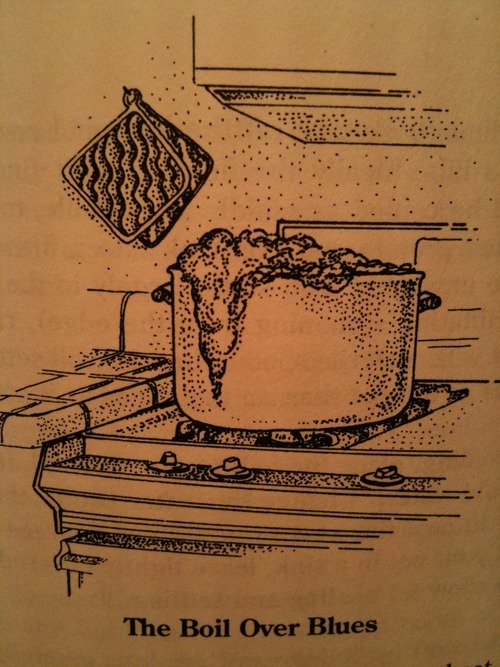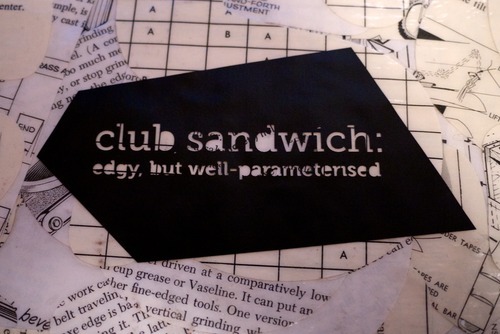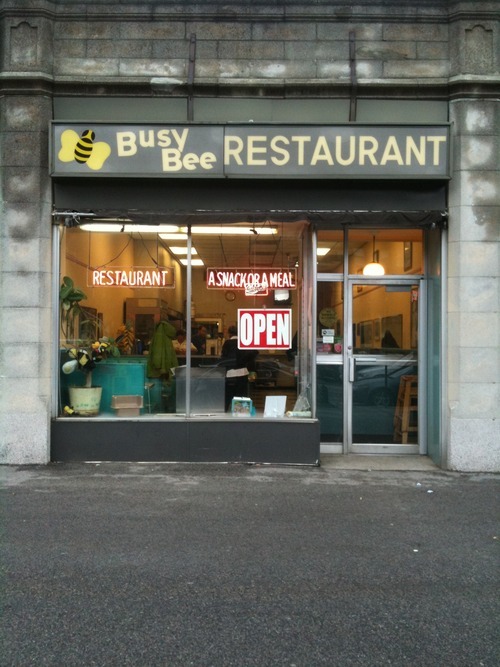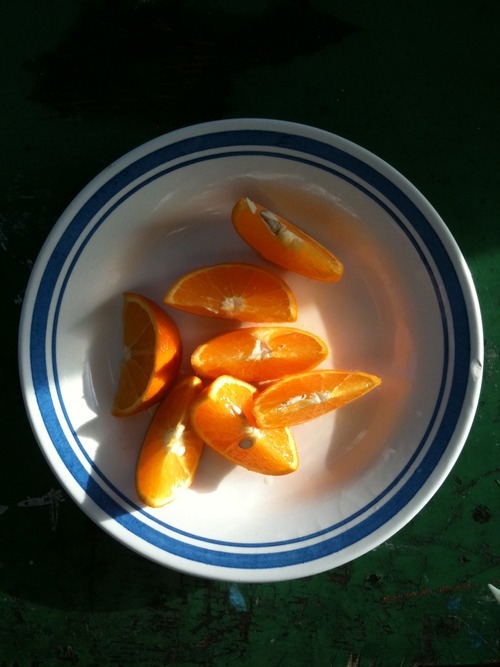Preparing things simply is deceptively difficult, since there is no way to cover up our mistakes.
edward espe brown, tassajara
Apr 28, 2011
mistakes
Posted by
vaughn tan
0
comments
![]()
![]()
Labels: books, food, instruction, intransigence, intuition, scalefree, theory
Apr 27, 2011
fast
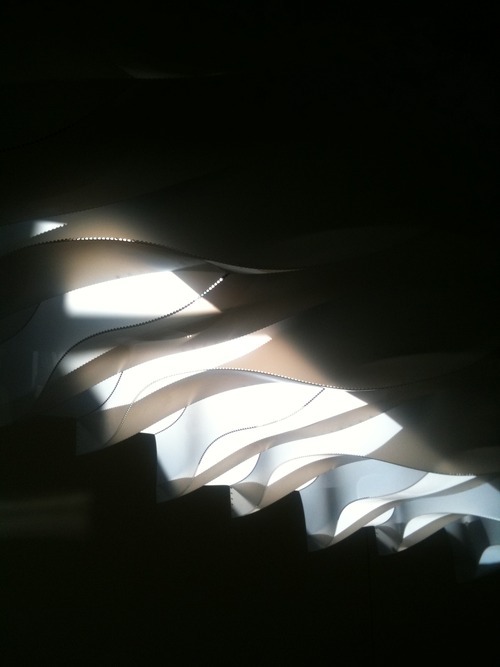 a view of overliner, from mit's 150th anniversary celebrations.
a view of overliner, from mit's 150th anniversary celebrations.
Posted by
vaughn tan
0
comments
![]()
![]()
Apr 21, 2011
Apr 19, 2011
the perpetual motion machine
"When we started, we thought we were looking for smart people, but it turned out that intelligence was not as important as we expected. If you imagine someone with 100 percent determination and 100 percent intelligence, you can discard a lot of intelligence before they stop succeeding. But if you start discarding determination, you very quickly get an ineffectual and perpetual grad student."
Posted by
vaughn tan
0
comments
![]()
![]()
Labels: epistemology, moral fibre, theory
otomata
this generative sequencer is very neat. it is a set of rules that "produces chaotic results in some settings, therefore you can end up with never repeating*, gradually evolving sequences."
Q: You are a filthy liar! You can't create "never repeating" patterns with a system whose state space is finite!
A: You are right. I should have said "(practically) never repeating" above. But please do the math, it is possible (but not proven) that there might exist some configurations where the exact repetition would take (billions of billions of times) longer than the known age of our universe. I am not a mathematician by any means, so that is as far as infinity goes for me (I also believe that light travels in infinite speed in a vacuum, come at me bro! I am a digital being, speed of light is my universe's sampling rate).
Posted by
vaughn tan
0
comments
![]()
![]()
Labels: execution success, music, scalefree, technology, transient
Apr 17, 2011
strategies, tactics
a strategy is "the calculus of force-relationships which becomes possible when a subject of will and power … can be isolated from an 'environment.' A strategy assumes a place that can be circumscribed as proper and thus serve as the basis for generating relations with an exterior distinct from it." these opposing ways of acting, strategy and tactics, are ideal types and there is a combination of strategy and tactic in every action; the issue here is that tactics become a much more significant part of action under conditions of diffusion. In this, certeau's definition of strategy makes reference to a situation marked by coherence and clarity in one key respect—a "place" is a domain of clearly-defined activity, and strategy can be the dominant strategy only possible in such a domain where there are clear means to ends. a tactic, on the other hand "has at its disposal no base where it can capitalize on its advantages, prepare its expansions, and secure independence with respect to circumstances … it is always on the watch for opportunities that must be seized 'on the wing' … the intellectual synthesis of these given elements takes the form, however, not of a discourse, but of the decision itself, the act and manner in which the opportunity is 'seized'"—tactics are contextual in the most profound way and are dominant where the domain is not clearly-defined.
implicit in the actor's creation of a membership-seeking line based on the context in which it will be deployed is the belief that the line constitutes an argument that certain affiliations and characteristics—his story about himself—justify a relative position in the group. again, this activity is not unilaterally undertaken by the individual seeking a position in the group; rather, the argument and bargaining process is one undertaken as mutually-conducted negotiation. for the individual, the uncertainty inherent in the process of negotiating a valid group identity introduces the need for tactical behavior.
bricolage, the art of making-do exemplified by odysseus (the many-sided), is what individuals do on a daily basis, and certeau discusses the nature of use or consumption (the act of choice and decision-making) as a particular case of bricolage. In a more conscious way, individuals who seek to negotiate membership in a group also engage in a form of bricolage—action conditioned by contingency and constantly in flux. this same lens can be turned on the nature of identity construction. returning to the idea that tactics are decisions and actions, it is important to bear in mind that the construction by individuals of stories about themselves is a sequence of decisions and actions—tactics—contingent on an understanding sense of the group to which entry is being sought: "a tactic boldly juxtaposes diverse elements in order suddenly to produce a flash shedding a different light on the language of a place and to strike the hearer." agents construct themselves through this mix of strategies and tactics; their design to disrupt the target group's definition and change it in their favor.
Posted by
vaughn tan
0
comments
![]()
![]()
Labels: books, craft, intransigence, intuition, process, research, sociology, theory
Apr 16, 2011
rotavap

on the one hand:
- the documentation on this thing is awful.
- the evaporator flask (= $$$) is missing.
on the other hand:
- it's a rotavap.
Posted by
vaughn tan
0
comments
![]()
![]()
Labels: drink, food, process, research, technology
Apr 15, 2011
Apr 14, 2011
excavations
from the department of frozen and dried foods #2: chicken stock (7/11/2009)(!), koyadofu (9/27/2010), buckwheat soba (6/10/2010), red miso (3/1/2010), kailan, and daikon.
Posted by
vaughn tan
0
comments
![]()
![]()
Labels: execution success, food, history
Apr 12, 2011
the divine comedy
the divine comedy is a frankly stunning collection of installations by ai weiwei (last year's unilever artist at the tate bankside, who has not incidentally been arrested (as of april 3) by the chinese government), tomas saraceno, and olafur eliasson (the 2003 unilever artist). having only been to the eliasson installations i can say that they are wondrous in a subtle and unsettling way (about which more below), but the collection of the three artists together is stunning because i cannot imagine how harvard pulled off something so cool without getting terminally stuck in the mud of bureaucracy and administration.
the eliasson installation deserves a fuller post in the future, after i've gone back when the lights are on. i stopped by tonight after a lecture/panel by david brooks and discovered that the installations are powered only between 8am and 5pm each day. this is extraordinarily lame because this series of installations, like much of the other work eliasson has done, explores our perception of light and visual stimulus and deserves to be explored in the off hours when the exhibition space is mostly empty of people.
i openly admit to being a philistine who visits museums because they have good light and great spaces rather than nice art. with few exceptions, i'm not much of a fan of figurative painting or other things like that. what i do like is art that requires technical sophistication in execution, a thorough understanding (even if not a formal one) of perception, and a bit of a sense of humour (even when this is not obvious). hence a deep and abiding appreciation of donald judd (more judd here), robert irwin, fred sandback, michael heizer, richard serra (more serra here), and all those other people. (dia beacon is a great place to go for these artists, not only because their works are concentrated there but also because the museum itself is jawdroppingly gorgeous. the renovation of the beacon building was supervised by ... robert irwin.)
eliasson's work falls into this category. rumour has it that his atelier is staffed by a relatively enormous team of fabricators, which may account for the intricate construction of some of the pieces i saw tonight. but not all the pieces in the divine comedy are extraordinarily expensive, complex, and intricate. what is most delighting is that the best piece is almost the simplest one.
here are two views of it: one concave spherical section, mirrored on one side and penetrated around its edge with rods mounted exactly perpendicular to the surface at the points of mounting. the section is suspended by piano wire from the ceiling so that it rotates unpredictably and slowly. because the rods are perpendicular to the surface and close to the edge, their reflections are only minimally spherically distorted and connect with the non-occluded portion of the rod on the opposite side of the mirror. as such, they appear to penetrate through a clear piece of glass. however, when the section rotates to reflect a part of the room that has rectilinear objects in it, those relatively distant objects are considerably distorted, and the whole gives the appearance of what it actually is: a concave mirror. at other times, when the piece rotates to face a relatively featureless section of wall, it appears like a convex lens. the overall effect is of simultaneously perceiving a mirror, a lens, and a regular piece of glass at the same time; unsettling if you stop to think about it for even a moment. if he'd been able to make the section out of a much thinner material while still maintaining the concavity, the illusion and incongruity would have been total.
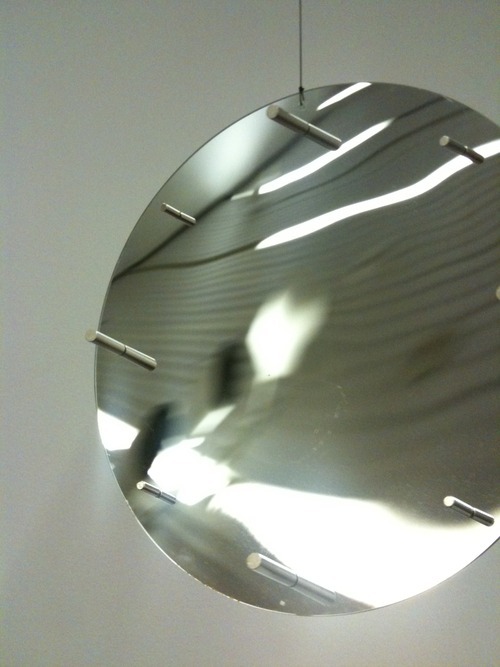
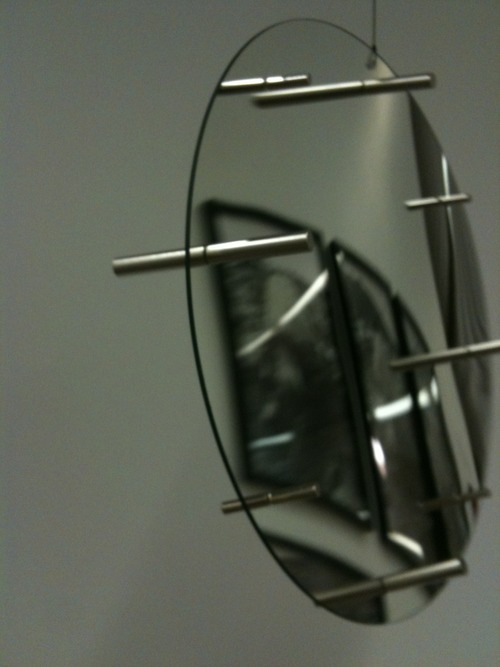
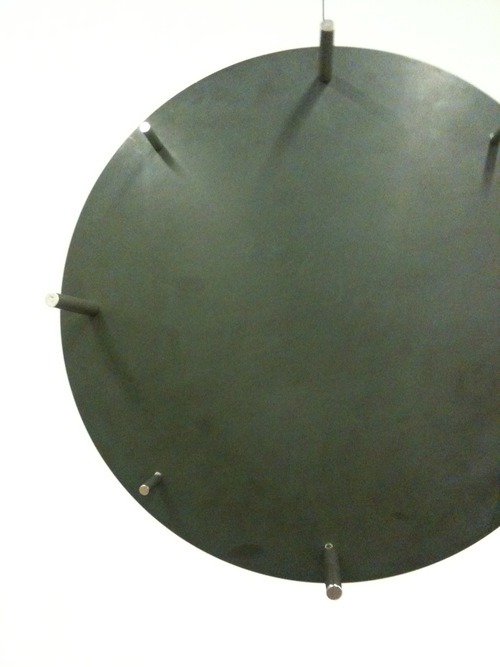
what's wondrous about the piece is that it forces the viewer to reconsider what an incredible exercise it is to interpret visual stimulus and come away with a snap identification of the thing being seen: a concave mirror, a piece of glass. donald hoffman's great and very accessible book on visual intelligence goes into some detail about the logic and processing behind these everyday miracles that happen in our heads, but eliasson's work (and especially that one piece described above) does so in the gentle, non-didactic, but insistent manner that is one of the hallmarks of great art.
eliasson is now chair of the Institut für Raumexperiment at the berlin university of the arts. this is a place i would like to visit.
Posted by
vaughn tan
0
comments
![]()
![]()
Labels: art, craft, design, execution success, neat, process, technology, theory
using things up
today, an archaeology of the freezer, in which we discover that a thick layer of oil is effective at preventing freezer burn.
cilantro, almond, garlic pesto (7/27/2010), maine rock shrimp (9/12/2010), oven-roasted cherry tomatoes (8/19/2009)(!), pecorino (10/10/2010), and linguine = lunch in 11 minutes.
Posted by
vaughn tan
0
comments
![]()
![]()
Labels: food
Apr 11, 2011
when the time comes
The love which brings the right answer is an exercise of justice and realism and really looking. The difficulty is to keep the attention fixed upon the real situation and to prevent it from returning surreptitiously to the self with consolations of self-pity, resentment, fantasy and despair. The refusal to attend may even induce a fictitious sense of freedom: I may as well toss a coin. Of course virtue is good habit and dutiful action. But the background condition of such habit and such action, in human beings, is a just mode of vision and a good quality of consciousness. It is a task to come to see the world as it is. A philosophy which leaves duty without a context and exalts the idea of freedom and power as a separate top level value ignores this task and obscures the relation between virtue and reality. We act rightly 'when the time comes' not out of strength of will but out of the quality of our usual attachments and with the kind of energy and discernment which we have available.[thx yen]
iris murdoch, the sovereignty of good
Posted by
vaughn tan
0
comments
![]()
![]()
Labels: care, complexity, decisions, epistemology, sustainability, theory
Apr 10, 2011
Apr 8, 2011
a partial history of new ideas in food

(thx corky, for the invitation. slides are here.)
Posted by
vaughn tan
1 comments
![]()
![]()
Labels: agriculture, art, coffee, craft, drink, food, history, sociology, stuff, technology, theory, transient
Apr 7, 2011
things to do
Michel Butor says that to travel is to write, because to travel is to read. This can be developed further: To write is to travel, to write is to read, to read is to write and to read is to travel. But George Steiner says that to translate is also to read, and to translate is to write, as to write is to translate and to read is to translate. So that we may say: To translate is to travel and to travel is to translate. To translate a travel writing, to read a writing, to write a writing, and to travel. But if because you are translating you read, and because writing translate, because traveling write, because traveling read, and because translating travel; that is if to read is to translate, and to translate is to write, to write to travel, to read to travel, to write to read, to read to write, and to travel to translate; then to write is also to write, and to read is also to read, and even more, because when you read you read, but also travel, and because traveling read, therefore read and read; and when reading also write, therefore read; and reading also translate, therefore read; therefore read, read, read, and read. The same argument may be made for translating, traveling, and writing.[thx mrm]
lydia davis*, "to reiterate," almost no memory
* i liked her translation** of in search of lost time
** i hope it's the same lydia davis.
Posted by
vaughn tan
2
comments
![]()
![]()
Labels: books, complexity, education, epistemology, process, translation
acceptance
Ariel: Hey
where did you disappear to? Someplace good?
me: ha
no
busy and unproductive
Ariel: acceptance of that is the key to happiness
me: 10 points
Posted by
vaughn tan
0
comments
![]()
![]()
Labels: execution failure, execution success, instruction, sustainability
Apr 6, 2011
superordination
We're not big fans of what I consider "vertical" ambition—that is, the usual career-path trajectory, in which a newbie moves up the ladder from associate to manager to vice president over a number of years of service. On the other hand, we revere "horizontal" ambition—in which employees who love what they do are encouraged to dig deeper, expand their knowledge, and become better at it. We always try to hire people who yearn to be master craftspeople, that is, designers who want to be great designers, not managers of designers; developers who want to master the art of programming, not management.
Posted by
vaughn tan
0
comments
![]()
![]()
Labels: epistemology, intransigence, process, scalefree, sociology, sustainability, technology, theory
Apr 3, 2011
Apr 2, 2011
things fall apart
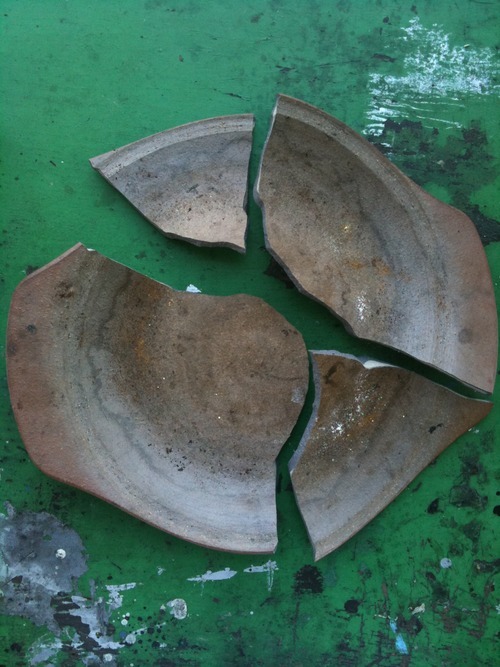
the awesome bread device died catastrophically yesterday while baking a 25% rye sourdough. i brought the carcass to judy motzkin and she thinks it may be a result of the firing process evolving a crystalline form of silica that makes the resultant clay more susceptible to thermal shock at the range of temperatures involved in baking tasty bread. she investigates even now. the universe of subjective knowledge expands outward at a speed far exceeding the individual's capacity to understand it.
Posted by
vaughn tan
0
comments
![]()
![]()
Labels: bread


